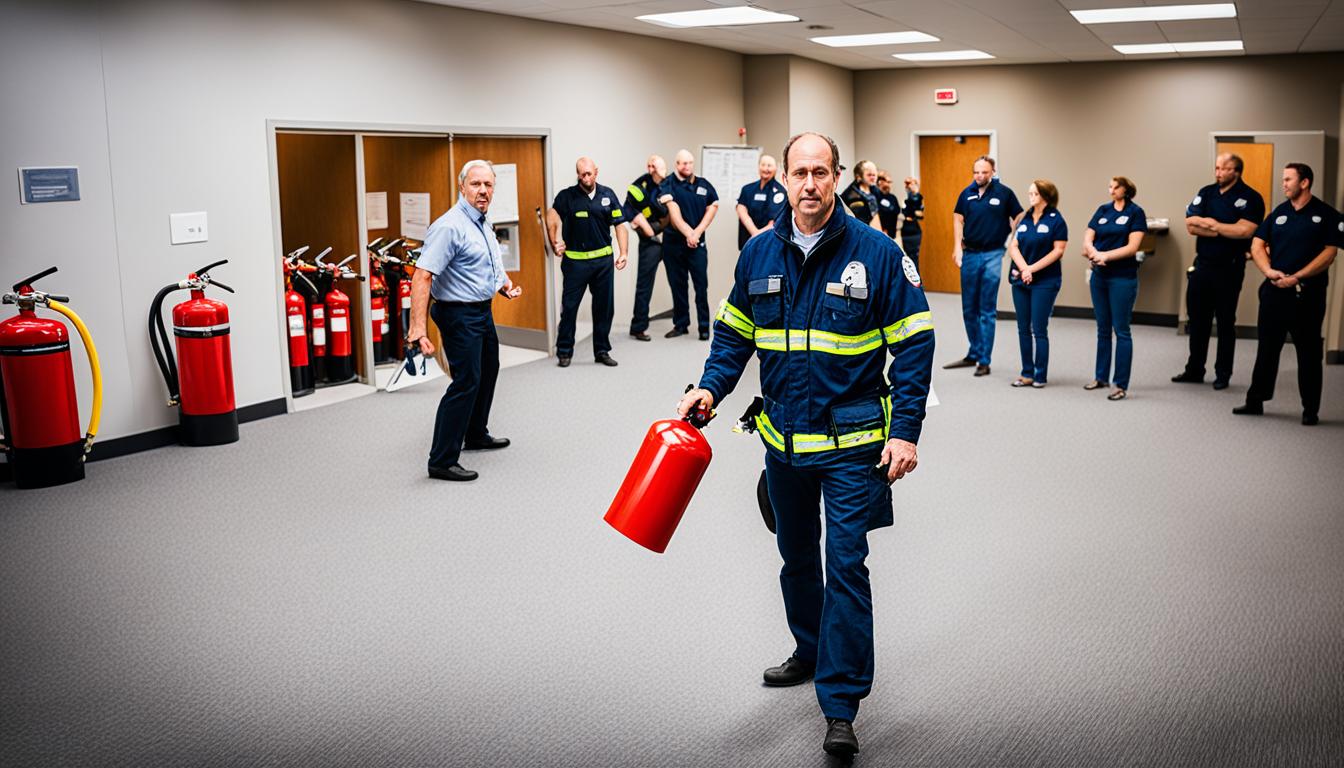Fires in the workplace occur in the UK and can be devastating to a business. All enterprises must take fire safety seriously to prevent unnecessary damages, injuries, and fatalities. A fire marshal plays a vital role in ensuring a business’s and its employees’ safety. With their specialised knowledge and training, they can recognise potential fire hazards and implement preventive and protective measures. From conducting regular fire drills to inspecting fire extinguishers, their presence can significantly reduce the risk of fires. Nominating a competent person to be a fire marshal is a crucial fire safety measure, and it helps businesses meet the requirements of the Regulatory Reform (Fire Safety Order) 2005 and the Fire Safety (Scotland) Regulations 2006.
Understanding the Role of a Fire Marshal
A fire marshal, also known as a fire warden, is an appointed person in an organisation. The main responsibility of a fire marshal is to assist with fire evacuations and safety procedures to ensure they are carried out safely. This includes raising the alarm in the event of a fire, calling the emergency services, guiding people towards the designated assembly points, and taking a roll call.
Responsibilities of a Fire Marshal
The role of a fire warden also includes checking fire safety measures and emergency procedures, such as emergency exits, fire doors, fire alarms, fire safety signs, emergency lighting, arranging for electrical equipment to be PAT tested, and checking fire extinguishers to ensure they are in working order. Nominating a competent person to be a fire marshal is a crucial fire safety measure, and it helps businesses meet the requirements of the Regulatory Reform (Fire Safety Order) 2005 and the Fire Safety (Scotland) Regulations 2006.
Legal Requirements for Fire Marshals
Businesses must consider the person responsible for the overall fire safety arrangements, together with key senior members of staff, when deciding who to train as a fire marshal. They should choose staff who are predominantly based on the premises rather than those who often work away, and avoid people in job roles with a high turnover of staff or those on temporary contracts. It is important to remember that the required number of fire marshals must be present at all times, so businesses need to provide cover for shift patterns, sickness, holidays, and other absences. All fire marshals require the same level of training, which should include instruction on their roles and responsibilities, fire safety measures, evacuation procedures, and how to respond in the event of a fire.

Assessing the Level of Fire Risk
The first step in determining the appropriate number of fire marshals for a workplace is to assess the level of fire risk. This assessment should have already been conducted as part of the comprehensive fire risk assessment process. There are three primary levels of fire risk to consider: low, medium, and high.
Low Fire Risk Workplaces
Workplaces with a low fire risk typically have few highly flammable materials present, minimal heat sources that could ignite a fire, no high-risk groups of occupants, traditional construction that is well-maintained, and clear, safe escape routes. These types of workplace emergency planning environments pose a relatively low risk of fire and require fewer fire marshals to ensure effective evacuation procedures.
Medium Fire Risk Workplaces
Workplaces with a medium fire risk have some highly combustible materials present, a few heat sources that could ignite a fire, several high-risk individuals occupying the premises, and suitable measures implemented to confine or slow the spread of a potential fire. In these fire risk assessment scenarios, a greater number of fire marshals may be necessary to guide occupants to safety and monitor the effectiveness of safety protocols.
High Fire Risk Workplaces
Workplaces with a high fire risk have significant amounts of highly flammable materials, multiple heat sources that could ignite a fire, a layout that would slow down the speed of an evacuation, construction that allows for rapid fire spread, and many high-risk individuals present. In these high-risk building occupancy limits environments, a larger number of fire marshals are typically required to ensure the safety of all occupants and comply with workplace fire safety regulations.

Factors Influencing the Number of Fire Marshals
Alongside the level of fire risk that a workplace poses, several additional factors should be considered when determining the number of fire marshals a business requires. These include the building’s size and layout, the number of employees and occupants, and the presence of high-risk groups within the workplace.
Building Size and Layout
The number of floors in a building is a crucial consideration, as there must be at least one fire marshal for each floor. This ensures that the fire marshal can effectively coordinate the evacuation and monitor the safety of all occupants on their assigned level.
Number of Employees and Occupants
The number of people in the building, combined with the level of fire risk, also plays a significant role in determining the required number of fire marshals. Typically, a low-risk workplace requires one fire marshal per 50 people, a medium-risk workplace requires one per 20 people, and a high-risk workplace requires one per 15 people. This ensures that there are enough fire marshals to guide everyone to safety in the event of an emergency.
Presence of High-Risk Groups
Businesses must also consider the presence of any high-risk groups within the workplace, such as individuals with mobility issues, hearing impairments, or other disabilities. Additional fire marshals may be needed to provide specialised assistance and ensure the safe evacuation of these vulnerable occupants.
By carefully considering these factors, businesses can determine the appropriate number of fire marshals needed to maintain workplace safety and emergency preparedness.
How Many Fire Marshals Should Be Appointed in a Workplace?
The specific number of fire marshals that a workplace requires will vary depending on a range of factors, including the level of fire risk, the size and layout of the building, the number of employees and occupants, and the presence of high-risk groups.
For a small office over two floors employing 40 people, with one hard of hearing employee and a medium level of fire risk, the recommendation would be to appoint at least five fire marshals:
- Two to cover the number of people in the building (one per 20), with one marshal on each floor
- One to help the high-risk member of staff who is hard of hearing
- Two to cover holidays, sickness, and other absences
For complex workplaces or those in which there is any doubt about the number of fire marshals required, it is recommended to contact the local fire and rescue service for further advice.
Maintaining workplace safety and adhering to fire safety regulations are crucial. Having the right number of fire marshals in place, who are well-trained and prepared, can significantly improve emergency preparedness and ensure efficient fire evacuation procedures in the event of an incident.

Fire Marshal to Employee Ratio Guidelines
The number of fire marshals required in a workplace is determined by an assessment of the fire risk, which considers factors such as the building type, its use, the number and types of occupants, and the business’s typical operations. This crucial evaluation helps employers ensure they have the appropriate fire safety measures in place to protect their employees and premises.
Low Risk Workplaces
For low-risk workplaces, the recommendation is one fire marshal per 50 people. These are typically environments with few highly flammable materials, limited heat sources that could ignite a fire, and clear, safe escape routes. The fire risk is considered relatively low, and a smaller number of fire marshals can effectively manage the situation in the event of an emergency.
Medium Risk Workplaces
In medium-risk workplaces, the recommendation is one fire marshal per 20 people. These environments may have some highly combustible materials, certain heat sources that could start a fire, and suitable measures in place to confine or slow the spread of a fire. The increased fire risk necessitates a higher ratio of fire marshals to ensure efficient evacuation and response.
High Risk Workplaces
For high-risk workplaces, the recommendation is one fire marshal per 15 people. These are environments with significant amounts of highly flammable materials, multiple heat sources that could ignite a fire, and a layout that may impede the speed of an evacuation. The higher risk requires a greater number of fire marshals to guide everyone out safely and scout the designated area for any individuals left behind.
Ultimately, a professional fire risk assessment is the best way to determine the appropriate fire marshal to employee ratio for a specific workplace, as it takes into account all the relevant factors to ensure compliance with workplace fire safety regulations.

Training and Appointment of Fire Marshals
When deciding who to train as a fire marshal, businesses must carefully consider the individuals responsible for the overall fire safety arrangements, as well as key senior members of staff. They should prioritise employees who are predominantly based on the premises rather than those who often work away, and avoid selecting people in job roles with a high turnover of staff or those on temporary contracts.
Fire Marshal Training Requirements
All fire marshals require the same level of comprehensive training, which should include detailed instruction on their specific roles and responsibilities, fire safety measures, evacuation procedures, and how to respond effectively in the event of a fire. This training is essential to ensuring fire marshals are equipped with the necessary knowledge and skills to maintain workplace fire safety regulations, implement fire safety training, and guide employees through effective fire evacuation procedures.
Appointing Competent Fire Marshals
It is important to remember that the required number of fire marshals must be present at all times, so businesses need to provide adequate cover for shift patterns, sickness, holidays, and other absences. By appointing competent individuals who are suitably trained and available to fulfil their duties, businesses can ensure they meet the necessary workplace fire safety regulations and safeguard their employees in the event of an emergency.
Conclusion
In conclusion, the appointment of a sufficient number of competent fire marshals is a crucial aspect of workplace fire safety. By understanding the role and responsibilities of a fire marshal, assessing the fire risk in the workplace, and considering the factors that influence the number of fire marshals required, businesses can ensure they have the necessary measures in place to protect their employees and premises in the event of a fire.
Regular fire marshal training and the appointment of suitably qualified individuals are essential to maintaining effective fire safety protocols and compliance with relevant regulations. Ultimately, investing in a robust fire safety plan, including the appropriate number of fire marshals, can help businesses safeguard their operations and minimise the devastating consequences of a fire.
By prioritising workplace safety and implementing comprehensive fire evacuation procedures, businesses can ensure their employees are well-prepared and protected in the event of an emergency. This not only safeguards the wellbeing of the workforce but also contributes to the overall resilience and success of the organisation.
FAQ
What is the role of a fire marshal in the workplace?
A fire marshal, also known as a fire warden, is an appointed person in an organisation whose main responsibility is to assist with fire evacuations and safety procedures to ensure they are carried out safely. This includes raising the alarm in the event of a fire, calling the emergency services, guiding people towards the designated assembly points, and taking a roll call.
What are the legal requirements for fire marshals in the workplace?
Nominating a competent person to be a fire marshal is a crucial fire safety measure, and it helps businesses meet the requirements of the Regulatory Reform (Fire Safety Order) 2005 and the Fire Safety (Scotland) Regulations 2006.
How do I assess the level of fire risk in my workplace?
The first thing to consider when calculating how many fire marshals a business requires is the level of risk that a workplace poses. This should already have been determined as part of the fire risk assessment process, which considers factors like the presence of flammable materials, heat sources, and high-risk groups.
What factors influence the number of fire marshals needed in a workplace?
Alongside the level of risk, several additional factors should be considered when determining the number of fire marshals a business requires, including the number of floors in the building, the number of people in the building, and the need to have additional fire marshals to cover sickness, holidays, and other absences.
How many fire marshals should be appointed in a workplace?
The specific number of fire marshals that a workplace requires will vary depending on a range of factors, including the level of fire risk, the size and layout of the building, the number of employees and occupants, and the presence of high-risk groups. As a general guideline, low-risk workplaces require one fire marshal per 50 people, medium-risk workplaces require one per 20, and high-risk workplaces require one per 15.
What are the fire marshal to employee ratio guidelines?
For low-risk workplaces, the recommendation is one fire marshal per 50 people. For medium-risk workplaces, the recommendation is one fire marshal per 20 people. For high-risk workplaces, the recommendation is one fire marshal per 15 people.
What training and qualifications are required for fire marshals?
All fire marshals require the same level of training, which should include instruction on their roles and responsibilities, fire safety measures, evacuation procedures, and how to respond in the event of a fire. Businesses must ensure that the required number of fire marshals are present at all times, providing cover for shift patterns, sickness, holidays, and other absences.




